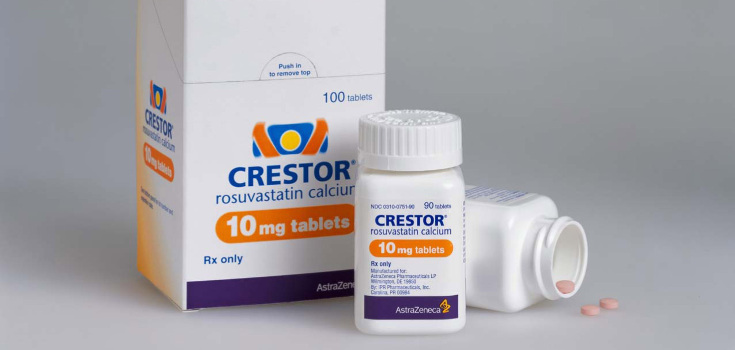AstraZeneca Makes World’s Best-Selling Drug, But . . .
AstraZeneca Makes World’s Best-Selling Drug, But .
It may do more harm than good
Perhaps you’ve heard of America’s most prescribed drug? It is in a class called statins and goes by the name of Crestor (rosuvastatin). It is marketed with the intent to ‘treat’ high cholesterol, and heart disease, but its effectiveness is deeply in question. It certainly doesn’t warrant the $5.8 billion in sales just in America annually, nor the $8.2 billion in revenues worldwide.
So how did this pharmaceutical drug made by AstraZeneca get so popular?
For one, the company made sure that certain ‘studies’ commented favorably on Crestor. For instance, one presented bythe American Heart Association claims that AstraZeneca’s statin reduces cardiovascular risk in those with normal cholesterol by 45%.
Another Harvard-led study called JUPITER also claimed statins were the end-all-be-all for heart disease, but guess who the study was funded by? AstraZeneca . The pharmaceutical company was smart to get Harvard to back up theirclaims that “if you take statins like Crestor, you’ll have 54% fewer heart attacks than the placebo subjects, as well as 48% fewer strokes, and 20% fewer deaths.”
Just in case you weren’t aware, a survey of clinical trials has revealed thatwhen a drug company funds a study, there is a significantly increased chance that the drug will be perceived as effective. Surprising, isn’t it?
You might be thinking – well with statistics like these, who wouldn’t want to be taking AstraZeneca’s meds? Apparently America agrees with that notion since one in four Americans over the age of 45 are now on a statin drug.
They are usually prescribed to individuals for the primary prevention of heart attacks and strokes, but these can be avoided by practicing good lifestyle choiceslike eating right and staying physically active (not to mention lowering stress through practices like yoga, meditation, and tai chi, which have all been linked tobetter cardiovascular health).
Somehow, though, AstraZeneca convinced the medical world that stains were some kind of holy grail. Why?
AstraZeneca’s drug therapy over lifestyle choices appears to offer little by way of primary prevention, with some alarming risks to go with that prescription. One study found that for every 10,000 people taking a statin, there were:
307 additional patients with cataracts 23 more patients with acute kidney failure 74 additional patients with liver dysfunctionAnother scientific review found that statins were even worse for women, actually increasing their riskfor cardiac disease. It also showed that statin therapy increased:
Muscle fatigabilty by 30% with more than 11% incidence of rhabdomyolysis (a life-threatening muscle condition) at high doses Coronary artery and aortic calcification Erectile dysfunction, which is 10 times more common in young men taking the lowest dose of statin. Lowered testosterone in men, and lowered libido in both sexes. Diabetes CancerNew rules for prescribing statin drugs were passed several years ago which allowed AstraZeneca to sell almost double the amount they were already pedaling. The company competed with other drug companies by undercutting Merck’s ($MRK) cholesterol drugs Vytorin and Zetia, along with AbbVie’s ($ABBV) fenofibrate-based lipid meds TriCor and Trilipix.
The American Heart Association guidelines threw out the numbers-oriented approach to statin use in favor of a risk-based analysis, which meant that if your doctor thought you were at risk for heart disease, you could be prescribed AstraZeneca’s “fixer-upper.”
Eric Topol, a well-known cardiologist and professor of genomics at Scripps Research Institute thinks we are totally overdoing statins:
“Statins have been available since the 1980s but their risk of inducing diabetes did not surface for nearly 20 years. When all the data available from multiple studies was pooled in 2010 for more than 91,000 patients randomly assigned to be treated with a statin or a sugar pill (placebo), the risk of developing diabetes with any statin was one in every 255 patients treated.
But this figure is misleading since it includes weaker statins like Pravachol and Mevacor — which were introduced earlier and do not carry any clear-cut risk. It is only with the more potent statins — Zocor (now known as simvastatin), Lipitor (atorvastatin) and Crestor (rosuvastatin) — particularly at higher doses, that the risk of diabetes shows up. The cause and effect was unequivocal because the multiple large trials of the more potent statins had a consistent excess of diabetes.”
He is among other doctors who think statins have been over-prescribed, and the market doesn’t look favorablyupon these drugs either as patents are about to expire for many big sellers. Considering that statins have now also been linked to thyroid cancer in women– isn’t it time to give them a rest?
Almost $6 billion dollars could be saved in the process, and our heart health would be remedied – accompanied by a sigh of relief.
Image from: YourLawyer
| About Christina Sarich: | |
| Christina Sarich is a humanitarian and freelance writer helping you to Wake up Your Sleepy Little Head, and See the Big Picture. Her blog is Yoga for the New World. Her latest book is Pharma Sutra: Healing the Body And Mind Through the Art of Yoga. | |
Other Popular Stories:

Post a Comment